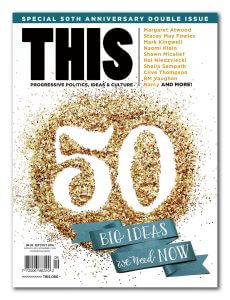Canadians need to stop improving gentrifying neighbourhoods
It's our opportunity to put the brakes on run-away real estate prices
John Lorinc@johnlorinc
 For our special 50th anniversary issue, Canada’s brightest, boldest, and most rebellious thinkers, doers, and creators share their best big ideas. Through ideas macro and micro, radical and everyday, we present 50 essays, think pieces, and calls to action. Picture: plans for sustainable food systems, radical legislation, revolutionary health care, a greener planet, Indigenous self-government, vibrant cities, safe spaces, peaceful collaboration, and more—we encouraged our writers to dream big, to hope, and to courageously share their ideas and wish lists for our collective better future. Here’s to another 50 years!
For our special 50th anniversary issue, Canada’s brightest, boldest, and most rebellious thinkers, doers, and creators share their best big ideas. Through ideas macro and micro, radical and everyday, we present 50 essays, think pieces, and calls to action. Picture: plans for sustainable food systems, radical legislation, revolutionary health care, a greener planet, Indigenous self-government, vibrant cities, safe spaces, peaceful collaboration, and more—we encouraged our writers to dream big, to hope, and to courageously share their ideas and wish lists for our collective better future. Here’s to another 50 years!
If you’re a This Magazine reader, you almost surely have an opinion about gentrification—that either it’s good or bad. Otherwise known as neighbourhood renewal, gentrification has come to dominate the discourse around modern urban development. And no wonder. When coupled with the hockey stick-shaped inflation in the housing market, gentrification has made urban living increasingly less affordable for those who don’t command six-figure salaries. These are the same people who do all the essential work that allows cities to function: teachers, nurses, personal support workers, public servants.
The issue I want to raise is how municipalities can become more proactive about the ripple effects of this rapidly accelerating process. Namely, I want to ask: Why should municipal officials go out of their way—as often seems to be the case—to improve neighbourhoods experiencing gentrification? Why don’t they instead pursue a form of negative planning—becoming incrementally less responsive to homeowner concerns, or promoting development projects that conflict with the quality of life in up-and-coming neighbourhoods? Why don’t local governments deliberately seek to make these areas less desirable as an antidote to run-away real estate prices?
Stay with me here. As someone who has been writing about municipal affairs for more than 20 years, I’m keenly aware my foregoing questions are more rhetorical thought experiment than workable policy proposal. But I still think it’s worth pulling this thread if only to explore how the cycles of gentrification, real estate speculation, and municipal re-investment reinforce and amplify one another—thus accelerating the interlinked affordability and housing crises that afflict big cities. The privileging of gentrification is baked into certain types of municipal policies—for example, the cash-for-density-bonus mechanisms, such as Ontario’s Section 37/45 rules. Under them, municipalities allow developers to add density in exchange for money invested in local improvements—new or improved parks, art spaces, public art, daycare spaces, etc. (Other jurisdictions have similar versions of these policies.)
The ostensible justification is that such funds are invested in public amenities that become necessary due to the incremental population growth that comes with increased density. The reality, however, is quite different.
In Toronto, for example, hundreds of millions of dollars in Section 37/45 funds, paid by high-rise condo developers, land in neighbourhoods experiencing intensification. But intensification is often a manifestation of desirability: developers build in sought-after areas that are already seeing an influx of capital and discretionary spending. The residents of these same neighbourhoods then receive additional benefits, in the form of new amenities, which, in turn, make their homes even more desirable, thus attracting other developers. In short, the financial benefits from these developer contributions accrues—in the form of higher property values—to the residents in these communities. It all gets very circular.
I’d argue that for cities facing skyrocketing housing prices (including rents), the only justified use of such funds in gentrifying neighbourhoods is the creation of new affordable housing. I am surprised to find myself agreeing with former Toronto councillor Doug Ford (brother of the late mayor Rob) who argued during the 2014 mayoral race that the millions collected from downtown developers should be spent to improve public amenities citywide, including less affluent communities that see little in the way of new development activity, and thus receive virtually no Section 37/45 money.
The point is that municipalities can, in fact, choose to impose a measure of control over the pace of gentrification and the intensity of the real estate speculation that accompanies it—one that could buttress the resiliency and sustainability of the entire city. A mindful approach would recognize that officially enabled gentrification will eventually become a self-consuming force that produces lovely neighbourhoods in which almost no one will be able to afford to live.
John Lorinc is a Toronto journalist and editor. He writes regularly about urban affairs, local history, and the environment. Lorinc is the author of two books on cities, as well as a co-editor of Subdivided: City-Building in an Age of Hyper-Diversity (Coach House).